|
These layouts were submitted by users
between 2005 and 2008. We are delighted to have them and we thank
the contributors. New submissions are always welcome.
Inland Belt Line
Another beautifully precise club-size layout by Ed Avetta.
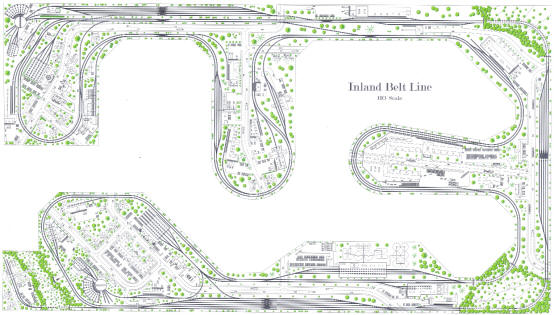
Benjamin's Room
by Harry Vig.
This is in Bachmann 1:20.3 scale using a 4-6-0 and four of five narrow gauge
mining and gondola cars.
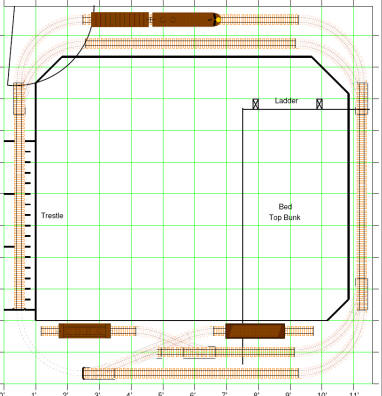
Guelph Junction RR
by Bruno Pigozzo.
GJ RR does NOT actually have any engines or rolling stock - just track in
the city of Guelph.
The CN main line runs through the city usually with long drags of container
cars, grain hoppers, and occasionally auto racks. In the 50s - early 90s, CN
ran some GP9 and GP38s to handle local switching. Today that task is handled
by the Goderich and Exter RR (GEXR) based out of Kitchener and points west.
GEXR uses GP38s mainly and also some GP40s plus one old SW1200.
CP Rail in the 50s - early 90s ran a mixed freight through the city to
switch key industries. Today that task is handled by Ontario Southern RR on
the CP lines. OSRR uses some old RSD18s and an old SW700 for its chores.
Passenger service is now only via the former CN station and features VIA
FP40s, Acelas and the occasional AMTRAK via Chicago. In recent history, Govt.
Ontario GO trains and CN RDCs serviced the needs of local citizens.
The hidden storage tracks are designed to handle at least 15 - 50' or 20 -
40' freight cars on the CP rail portion. For the CN portion similar freight
storage is provided for plus some space for a VIA train or and RDC car.
The local industries produce a variety of goods from water pumping and
purification equipment, hydro transformers, auto parts, cardboard box
containers, wood and steel products etc. Cars switched range from flat cars,
hoppers, boxcars, tankers and gondolas.
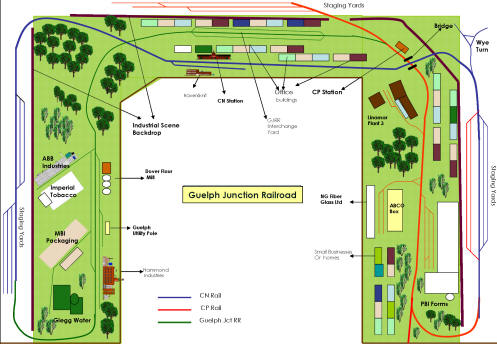
J
& B RailRoad
by John Hill.
Outer edges will be at "ground level" with a mountain in the upper left
corner and another in the center extending to the right corners, thus making
the tunnels. The switches in the center tunnel will allow for "guessing
games" with the grandchildren (where will the train appear next?) This is a
jpg file with the drawing originally created in Microsoft Power Point, so
turnout angles are not precise.
Instructions: Obvious switchback headaches.
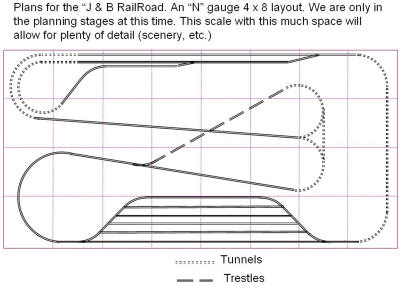
J
& J Railroad
by Larry White.
I am sending you the J & J HO layout, the existed during the seventies.
The gray area is a wall made from metal shelves with paneling of the train
room side.
The area under the stairs was plain plywood, but it did not look right on
the drawing. I had to build a plastic "tent" under the stairs to keep the
dust off the rails (big problem). I removed the plaster board front the wall
where the tracks entered the area. The track ran between the wall studs. The
"mountain" I envisioned to cover them, never got built.
Much of the layout was undecorated, most of the buildings were hand made
from cardboard.
While I liked to have operating sessions, I also liked to watch trains run.
I used Atlas "Right Trak" software to make the track plan and Paint Shop
Plus to add the details and color(any graphics package would work). The
point is that I didn't need TrackLayer to perform these functions.
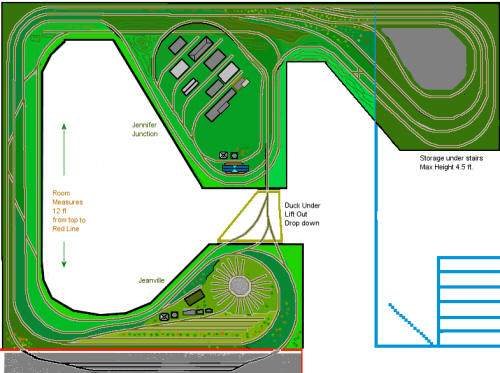
Lancaster N-Scale
by David Lancaster.
I have my own layout that I took a picture of and did the trackwork with
Trainplayer. I would like to offer it to your site for free ing by
others. I have checked all of the track and switches. Everything functions
perfectly. The original trackwork is 8' long and 3.5' wide and is an N scale
layout.
I have been working on this 3.5' wide by 8' N scale layout off and on for 20
years. I really don't have a name for this layout. There is an outer loop
and an inner loop which has an inverted dogbone over itself. The layout
actually folds in half and stores on it's side. I take this layout once a
year to a nearby train show (Great Train Expo). Originally, there was to be
a station in the middle, but I don't permanently attach any buildings so
ayous to be able to have a different looking layout at each set up. In the
upper left hand corner (where the snow is), there is a removable hill which
makes the inside a night scene. I use security door eyepieces mounted at
"human" level to force perspective - to make you feel only about 1/2" tall.
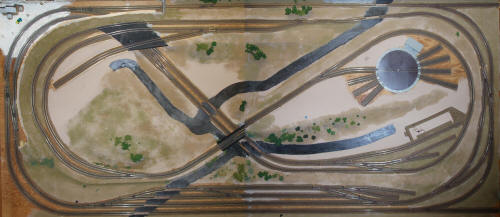
Boar Harbor (Long Island Railroad)
by George Bacon.
Fast paced passenger action on a shelf type layout. Also boasts engine
service, a small freight yard and harbor switching. Work against the clock
with scheduled incoming and outgoing passenger trains on this
end-of-the-line commuter railroad. Things can get further complicated by the
occasional freight.
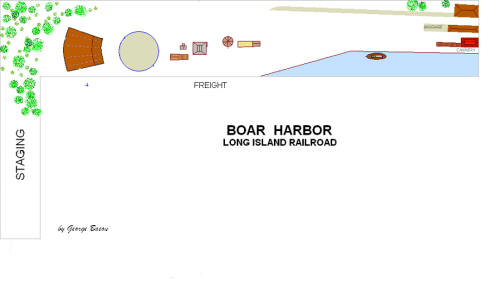
Oakland Harbour Belt
by Byron Henderson, tracked and submitted by Bruno Pigozzo.
I am attaching an email of approval of use from Byron Henderson (see his
website @ http://www.hendoweb.org/ohb)
who is a professional designer of model rail road plans for enthusiasts. His
Oakland Harbor Belt has huge operating potential and his supporting
documentation is superb.
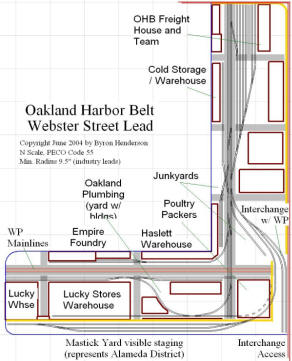
Ohio Southern Lower
by Jim Jendro.
This is the lower level of the Ohio Southern (see
Upper Level below).
The layout was cloned from Jim Hediger's "Ohio Southern" bi-level layout
(Feb 1983, MR). At some point I should add in station id's to match the
place names in the layout article. All the scenery was done with PaintShop
Pro.

THB Hamiton Dundas Sub
by Bruno Pigozzo.
The Toronto Hamilton
Buffalo's Hamilton Dundas Sub plan is built on an actual schematic that I
found in a history of the TH&B. Appropriate cars are already place on the
tracks. Makes for some interesting switching jobs. The grid squares get
really small but this makes for a more realistic urban railroad. I have
added a wye turn at one end and a loop at the other end of the track which
will allow for some continuous running.
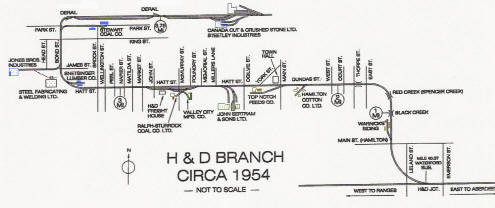
Wild Horse with Ships
By Larry White and Peter Lloyd-Lee. Based on a design by Ed
Avetta (the Wild Horse Timber &
MIning Co).
Suppress display of the track, and you will see a little boat running around
in the harbor.
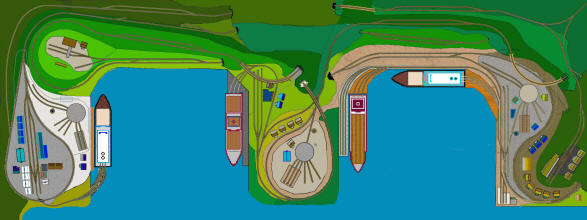
CP Layout
by Clarence Plisky.
Freelanced, continous running in midwest, (Indiana, Wisconsin) area. DCC
control, mid to late 1950's period.
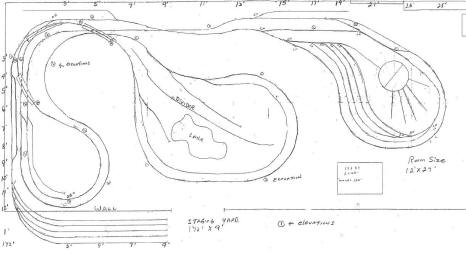
Coewydd Valley Line
by John Widdows.
The actual track plan I sent you is originally in black and white and has
been "coloured" up by me to make it look a little more realistic. It is
printed in a book called PSL Book of Model Railway Track Plans, writen by a
gent called C.J.Freezer and published by Thorsons Publishing Group,
Wellingborough, England in 1988. I like the layout because it has a terminus
at each end and also has two "through" stations. It is ideal for running
trains from a simple timetable - although they look fascinating I am not
keen on the large tail chaser layouts. Perhaps a case of different country,
different preferences.
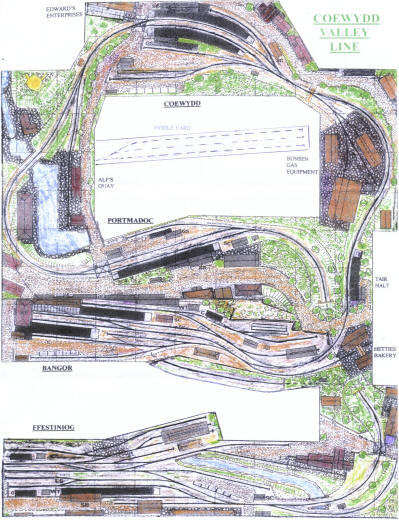
The squares are in fact for 12" for 00 gauge. The preamble
in the layout book is:- 00 gauge 4.00m by 3.00m. Steam motive power. Country
of origin UK. Other recommended gauges EM. HO & N . Minimum radius 500mm.
Train length 3 coaches. Small radius points. Extensive single track system
inspired by Colonel Stephen's light railway - the said colonel is famous, or
infamous for a very ramshackle railway he owned in southern England many
many years ago.
The layout is fairly typically English yet it doesn't jar the mind to see
half a dozen boxcars running along behind an Americal loco. Strange what we
can shut out and alter our imagination to.
Digital & Virtual RR
by Mike Henley.
HOn3 layout for an 8x12 room.
From Mike:
I just bought TrainPlayer, and I am quite excited about it. It offers what
3rd Planit (which I also own) does not: running trains in plan view. It is
nice to run in 3d, but if I add any more objects than the bare track, ground
and train, the redraw rate soars. With some buildings and trees on it, you
see a "flick show", of one frame at a time. And, I am running Windows 2000
Pro, a 2.3 Ghz processor, and 1 Gb of ram. Flight simulator runs beautifully
on this computer, as does TrainPlayer. 3rd Planit should too. The help
section in 3rd P does not say much about exporting files, and frankly, I
don't know if you can use my plan, but the expertise will have to come from
your end! :) I also own Cadrail, and not only is it a bit primitive, but I
cannot even load a plan into it right now. It can't find any swithces!!!, of
all things, and I can't run a train on it, on a predrawn, or personal
layout.
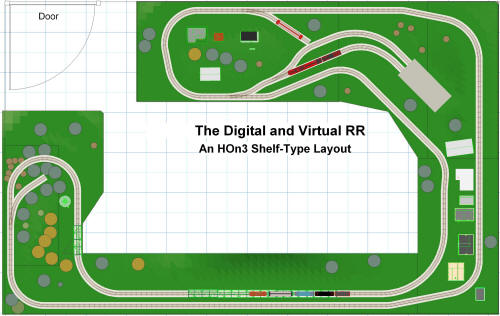
Connolly
RR
by Mike Connolly.
Double oval on 40"x108" peninsula on left leg of "U" plus small yard with
roundhouse and continuous run loop on right leg. Sharp curves and
short trains are necessary, although the switching possibilities are good.
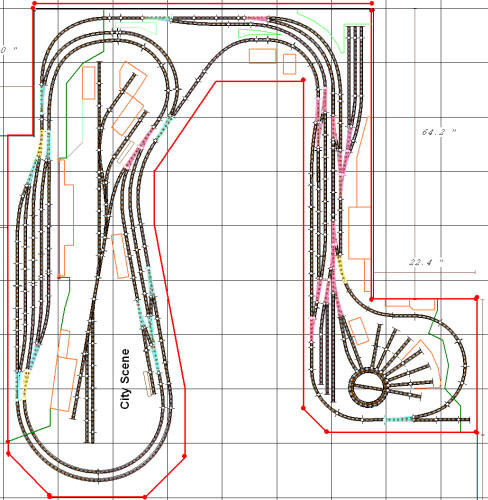
Jan's
Valley RR
by Jan Dreyer.
This will be my first major layout attempt. And I will start construction in
March 2007. I have a small 2,4m x 2,7m room available. The small valley
operation is designed for Steam and diesel locomotives. Jan's valley is an
imagination of activities. Somewhere between mountains and water ways
If the layout function would complement my imagination, I would surely enjoy
building, using and sharing it with you. I hope it meets your requirements,
if so, let us share if with others
Track by Peter Lloyd-Lee. From Peter:
This plan is based on a small N-scale layout being build by Jan Dreyer of
South Africa. The original plan calls for a 5-track train turntable beneath
the paper mill, but this has been replaced by a conventional staging yard
for ease of viewing. As Trainplayer has the facility to turn an entire train
end-for-end with a single keystroke, this arrangement works well.
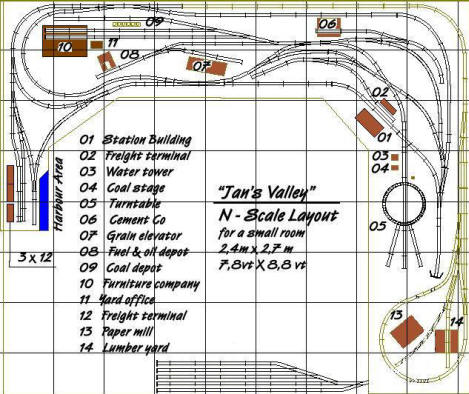
Northern Malone RR
by Michael Arnold.
This is a freelanced, H.O. layout and has a beer industry for you, also the
malone sheds to store your loco's and is for any era, and a staging line so
you can run 2 trains at once.
Track and staging yards by Peter Lloyd-Lee. From Peter:
This is a very simple "railfan" layout with large hidden staging yards. The
main operation format is to watch long trains running through a scenic
section. Very little on-line switching is necessary. For best effect, this
layout should be run with the tracks turned on.
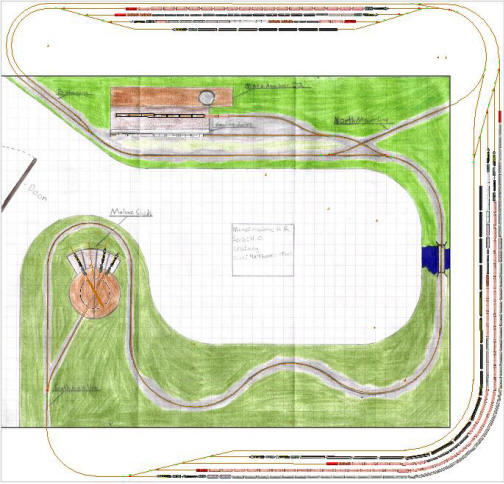
West
Lakes RR
by Caleb Beckedorf.
A simple oval on a hollow core door with the backdrop at an angle through
the center of the layout. A small yard on one side of the oval takes
up most of on side, with a couple of spurs on the other side.
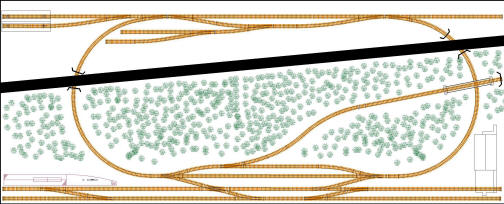
Lego
Layout
by Robert Fries. Track by Peter Lloyd-Lee.
I just came across TrainPlayer & TrackLayer for the first
time, and my immediate thought was "is there any way I could use this with
my Lego trains?"
This layout is set to OO scale, so the overall size and
train sizes come out about right.

Lizard
Head
Created using 3rd Plan-It by Chris Marco, TrackLayer track
by Peter Lloyd-Lee.
This plan is based on the trackage through Lizard Head pass. Extensive
staging tracks have been added to the original plan. For best effect, the
track display should be left on while operating.

Mike L
Layout
Created using 3rd Plan-It by Chris Marco, TrackLayer track
by Peter Lloyd-Lee.
This plan is based on a high-rail layout that runs around several obstacles
in the owner's basement.

Bree Turn
Switching Puzzle by Peter Prunka.
This is a set of dominos on my new AT&SF whch represent the
industrial city of Bree. It also makes one heck of a switching layout! You
are facing WEST, with North to your right and South to your left. The Bree &
Buckland RR at the rear is a narrow gauge line that serves the ancient
Hobbit region of Middle Earth. It crosses the AT&SF to serve Rivendell, now
a tourist resort. An interchange is maintained by manual loading and
unloading of freight.
Bree is a large industrial city in the Middle Earth of the Sixth Age. It is
served by a daily freight out of Fornost Yard to the North, as well as
several passenger trains each day. Also passing through town is the Bree &
Buckland RR, a narrow gauge road that serves the Hobbitish areas of Middle
Earth, as well as the tourist resort at Rivendell.
Layout comes with detailed assignment instructions and
rules. Good luck!

Steve
Z Layout
 by
Steven Zegalia. by
Steven Zegalia.
This layout is my attempt to do a figure eight inside an
oval doing all over-under crossings. The idea was to have a train go over
the entire mainline with out touching a switch. The sidings were added later
for on-layout storage.
Chantilly Central Railroad
by Joe Krueger. Trackwork and decoration by Peter
Lloyd-Lee. Two levels connected by helix.
This is a freelance railroad. So far, the long dogbone is tracked and
partially scenic-ed.


Lachlan
by John Noller. Trackwork by Peter Lloyd-Lee.
The is nothing particularly original about
the underlying set-up. It is the classic type of looped eight, with a
few bells and whistles. The main innovation, which I have not seen used
elsewhere, is to give part of the trackwork multiple identities,
enabling an operating schedule close to the prototype in a restricted
space (and on the actual model getting triple use out of some of the
buildings). This is explained in the accompanying notes and drawings,
which should be read in reverse order.
As I see it, the main difficulty in adapting
to your system would be labelling the schitzophrenic upper loop. The
various items (stations, industries etc.) could be given triple slash
separated identities for the three different line usages. If your
software can accommodate it, a more elegant solution would be to have a
three-way toggle switch for each of NORTH/SOUTH/BRANCH which would
display only the item identifiers for the line in use.
An improvement in the layout, which I did
not drop to until it was in use, would be to have at least two of the
sidings in the main holding yard accessible from the upper loop by a
facing switch near the duck-under, necessarily at a lower level than
those in the remainder of the yard. This would eliminate the
current need for cumbersome reversal of trains running on the "Main Line
South" to and from the holding yard.
As an alternative
to the layout as is, for a simulation where space restrictions are less
pressing than than on a real model, I could devise an end-to-end
adaptation having separate trackage for each of the North, South &
Branch lines.

Nickel Plate Wheeling District
by Kyle Young
Coal road based on southeastern Ohio, Nickel Plate Wheeling
District. Coal mine and power plant are connected through hidden
trackage for Loads in- Empties out operation. N scale, 12' x 12'.
I designed this myself to fit my workshop. The layout is located
overhead and use a 2' platform to stand on and operate it. It is loosely
patterned after the Nickel Plate Wheeling District. A coal road in
southeastern Ohio. It runs from Toledo to Wheeling and the portion from
Brewster to Adena is modeled. It has a mine at Adena and a powerplant
outside Brewster with a empties- in, loads- out connection. Toledo and
Wheeling in staging.

Pueblo-Canyon City-LaJunta
by Jerry Wilson
Yard in Pueblo serves Canyon City via Rio Grande and LaJunta
via Santa Fe. Early 1970 era.
Plan submitted in two sections via Atlas software. "To LaJunta" track in one
section connects to "To Canyon City" track on the 2nd section.


L & M Woodland Express
by Lynn Boyd.
This layout still has a bit of work to do with regards to a
few of the spurs. Most industries other than the coal mine in the
lower left are wood related servicing each other. The cad file is done
in xtrkcad.
The layout has an extensive hidden staging area. Both
layers are in the same layout.

Castleford High School
by Richard Martin and his club at Railsoft UK. A "what
if" project on a schoolyard photo.

Cheryl Junction
by Chris Marco and Jeff Zarend. Created using 3rd
Plan-It.

Stanley
Yard
by Jeff Zarend.
This is the Stanley Yard. I think it's currently owned by
CSX. It's located in Walbridge, Ohio, which is right outside of Toledo. If
you drive down State Route 795 you drive over part of the yard. It's
impressive. You can "google" for many different rail fan photos.

Pine Ridge RR
by Steve Feek.
Here is my first TrackLayer file! This is my 1x4
layout which is on my website. The layout, Pine Ridge (formally called
Blackwood) has been to a couple of local shows and people enjoy watching me
switch cars on the layout.
In this file - I extended the trackplan to give the user some room to do
some work, including adding the staging track.

Pennsylvania Railroad
Ohio Division Mainline
by Mike McKenzie.
This is a display type layout. It is N Scale on a 6.5’ X 16’ island with a
view divider in the middle. The staging side of the divider uses a city &
industry backdrop including some building flats for better depth. The rural
side uses a western Pennsylvania / eastern Ohio hills style backdrop with
the scenery blending into it. I have not shown any switching sidings since
this layout’s purpose is to show off long mainline trains in a scenic
setting. However, there is plenty of room to add sidings at various places
for a local to do some switching.
Detailed operation instructions are
included, along with two linked layouts for more variety. Open the
PRR_Ohio layout. The two wyes at the bottom lead to add-on layouts.

Ohio
Southern
by Jim Jendro.
This is the upper of a two-level layout. Track and
artwork by Jim.
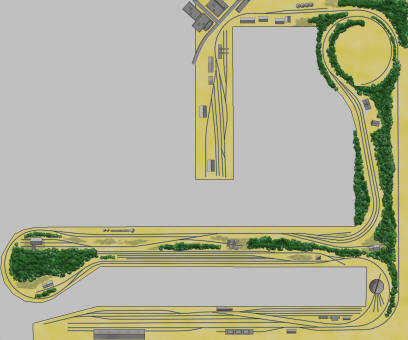
Lakeport Short Line
by Ed Avetta. Based on a design by George Baustert,
with art assistance by Bruce Bates and coloring by Jim Dill.

Colored version coming soon.
San Francisco Peninsula RR
by Enzo Fortuna.
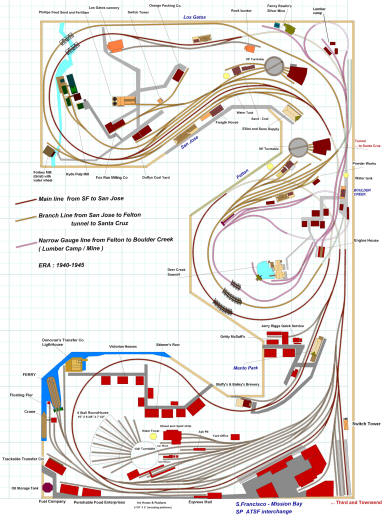 N
gauge and Nn3 short logging line. N
gauge and Nn3 short logging line.
Room Dimensions: 3,70 x 4,20 mt (12'15" by 13' 8" ) Track MicroEngineering
code 55. Turnouts on the visible mainline are mostly Peco. Main line 20,50 m
(not including staging leads) Branch line 10,32 m (not including staging
leads) Narrow gauge line 10 m Min mainline radius - 24" ( 60 cm ) Min
mainline turnout - #6 Min industrial turnout - #4 Era is around 1940 -1945.
Continuous run for shows or relaxed ops.
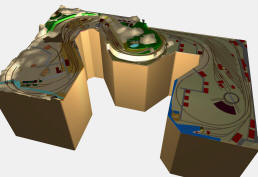
Description: Main line go from SF (I thinking about SP&ATSF interchange yard
at Mission bay + ATSF ferry + roundhouse and some industries) to San Jose
and Los Gatos. Main line is turning back to SF via a tunnel to separate the
view and enable to have continuous loop.
The San Jose yard is not so big as in reality but will provide the
Roundhouse facility at Lentzen Ave. as well some local industries. From San
Jose is departing a branch line to Felton ( and here a tunnel to a stage
track simulate the line to Santa Cruz ) At Felton there is a turntable and
an interchange with a little Narrow line ( Nn3 ) to Boulder Creek This
narrow line continue to a little lumber camp, and a silver mine, free-lanced
transfer for the New Almaden one. On the narrow line there is a sawmill.
This Nn3 line have two back-loops at both ends to turn the loco's
Designed using 3rdPlanit.
Shady
Brook
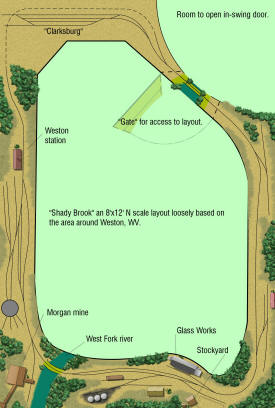 by Jim Jendro. by Jim Jendro.
Route
based on the area around Weston, WV as served by the B&O. The local glass,
coal, and gas industries are represented. The Clarksburg yard needs a lot of
work...
Jim created the track by hand, without using TrackLayer.
Aquebogue Light Railway
by Bruce Bates.
Small island lighthouse railways (2) both variations on the same theme. Ask
Peter Prunka, he has a sculpture of another variation. All in all two small
railroads with an interesting amount of operation designed in.
I was designing this for a contest in Yahoo's group "Small Layout Design"
and it was getting too big for the contest rules, so I had to modify it into
the ALR. The original concept offers more operation with two spurs at each
end of the line. You can figure out wherer the missing turn table should go, which should only be large enough for a short engine and
one car, as is the case on the ALR plan as well. [ Webmaster's note: the
missing turntable is supplied in the working version.]0-2-0 engines only
need apply.
See
Bruce's Site featuring the notorious
Birdwater and Raspberry.
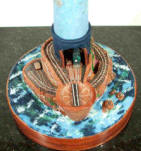 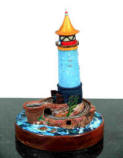
Peter Prunka: Bruce and I have been friends for 35
years. I have the 1/4 scale model of the ALR sitting on the desk in front of me,
lighthouse, wizard and all. It's a whimsy layout. He designed and built it for
me, the "Wizard of Aquebogue" (my former home). The railroad receives carloads
of beer and whiskey (and the occasional food) via car ferry and transports them
to the lighthouse storage area.
Photos by Bruce Bates. Click to enlarge.
Harrisburg RR
by Karl Stewart.
I built this layout in my garage. It had two scratch built hand held
throttles and cab control. A helix got you down from the outlying area into
the hidden staging under the city of Harrisburg. The Rockville bridge was a
scratch built 9 arch stone bridge over 2 feet long. In reallity it is many
many arches and is about 3/4 mile in length.
The circles to the left of the Rockville bridge was where I put Three Mile
Island even though it is actually about 10 miles downstream from there. The
river is the Susquehanna.
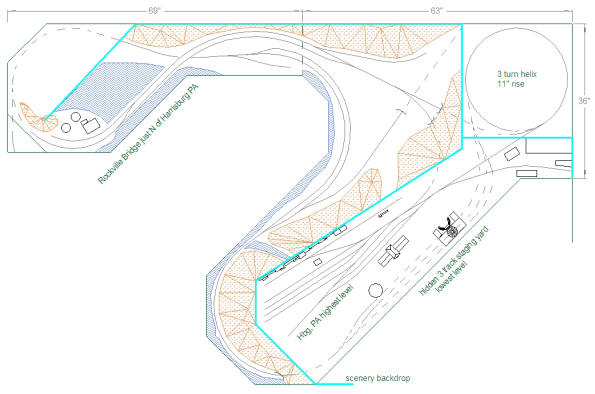
Industrial Portage Co.
by Ed Avetta.
This layout is just for having fun switching cars around from and to the
different industries. Wouldn't really want to build a layout like this, but
having a plan that I could play with, shifting rolling stock around, would
be a real pleasure.
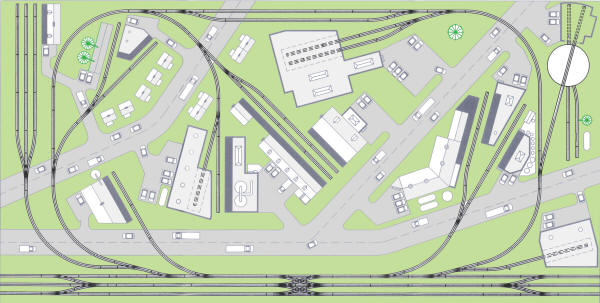
Ellensburg Railroad
by Mike Jones.
Two level switching layout with continuous run. Pier area designed for
Walthers Car Ferry and other units in that set.
Blue track is level at Elev 0". Red track rises at 4% grade to upper level
at Elev 3.75". Upper portion of blue track is hidden staging for two trains
and a Budd Unit for passenger service.
[Webmaster's note: we changed the colors. The green
track is high elevation, gray at ground level.]
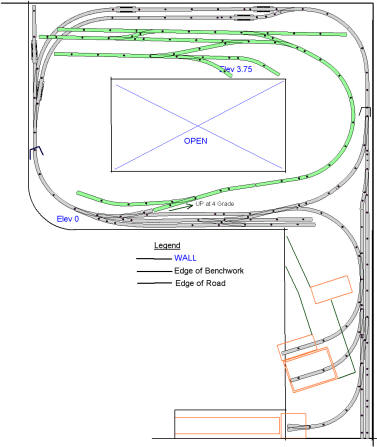
Ingersoll Terminal Railway
by Gary Pembleton.
Based loosely on a 1964 MR track plan New Orleans Public Belt Line. Allows
various industrial switching moves plus a branch to a rural station.
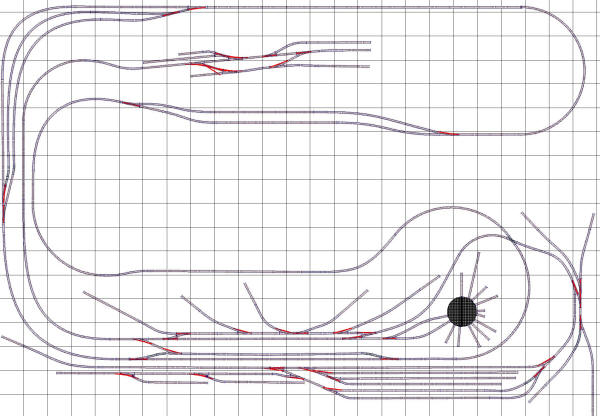
1x21
Switchback
by Steve Benezra.
This is a switchback plan to take cars from mines to a lower level. Since it
is a long space, the grades are under 3%. In HO shays, or other geared
engines can be used. in On30, Porters or geared engines can be used. There
is potentially quite a bit of operation in a long narrow space.

Schwartz Mine RR
by Steve Schwarz.
This is a standard and narrow gauge layout which has a working narrow gauge
steam museum in the lower left corner. There is an operational mine on the
upper level at the lower right corner. Steam engines leave the museum
grounds and grind up the 4% grade to the depot. The road engine then takes
waiting empties back down through the helix to the transloader for shipment
on standard gauge. The empties are taken up to the mine by a geared
locomotive and dropped off. Full cars are taken back down to the depot. A
switcher at the mine takes the empties through the tipple for loading.
There are also industries along the dual track mainline for more switching
action along with passenger stops. This layout combines modern diesel
operation with a plausible narrow gauge steam operation all at the same
time.
[Webmaster's note: this layout contains two files, one for
the lower level (shown here) and one for the upper, with a working 3-loop
helix in between.]
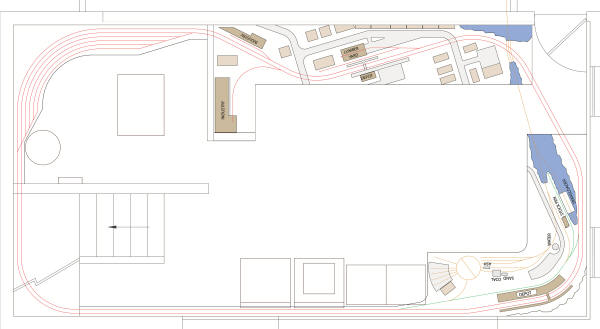
Ontario Western Lines
by Steve Feek.
I am building this 4x8 layout. When complete there will be staging and
interchanges with 4 other railroads! The OWL is a bridge line connecting
these 4 railroads.
.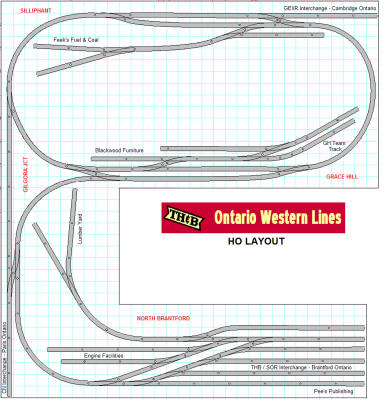
Wild Horse Timber & Mining Co.
by Ed Avetta.
Ed says: "This is a layout I have always wanted to build but didn't
have the space to do it. I was inspired to develop a mining and lumber
railroad by an article that I saw in the May, 1976 issue of Model Railroader
called "A Day at Mule Shoes Meadows" by John Olson. It was really a series
of dioramas that looked so real that they just made me feel what it was like
to have lived during a time like that. I still have a copy of that issue and
look at it now and then still wondering what it would have been like to live
in Mule Shoes."
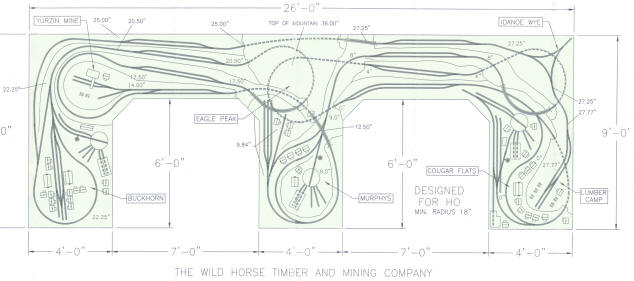
Wabeno Timberline Railroad
by Robert Prondzinski.
Ten interconnected sections in
schematic form, prepared by
Train Controller.
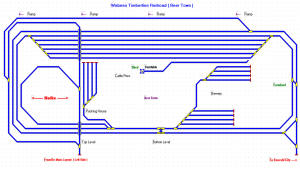
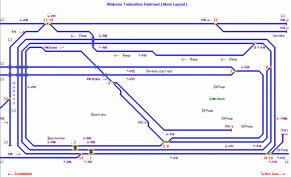
Santa Fe & San Antonio Railroad
by Lee Cook.
The Santa Fe and San Antonio Railroad
(SF&SARR) is a fictitious prototypical layout of a connector route between
the ATSF in Houston, Ft Worth and Santa Fe, similar to several of the small
feeder lines serving the San Antonio area. Scenery covers the Piney Woods of
East Texas, the Hill Country, the Big Bend Country and the Pueblo/Butte
areas of West Texas and New Mexico.
Certain scenes on some modules can be changed to accommodate
various periods - Early 1860-1890; Steam 1880-1950; Transition 1940-1960;
Diesel 1950-1990 and Modern 1990 to present day. Of course if you select
present day, it becomes the AMTRAK and BNSF with its arrival to serve the
new Toyota Plant. Since the SF&SA RR is basically a fictional railroad,
sometimes mixtures of all periods can be found running together, just for
the fun of Model Railroading.
Lee drew the entire layout in TrackLayer from scratch.
NOTE: this layout has a blank background. By default
it comes up with track display turned off, so all you see are the switch
lights. Use View Tracks to show the tracks. If you upgrade to
ver 2.18, this layout will automatically come up with tracks on display.
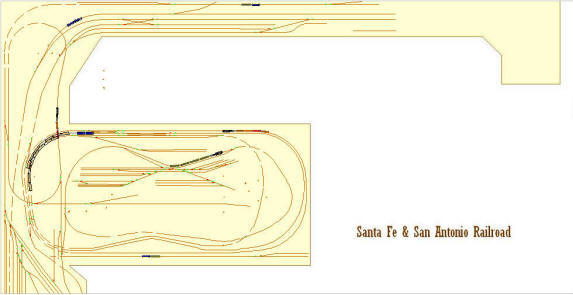
Binkley Railroad
by B. Binkley.
Simple yet functional design. Outside loop is a Freight Loop with Right
Switch To wrap around loop for future freight station use. Inside Loop is a
passenger loop running either throught the tunnel or bypass the tunnel to
the passenger station. 4x8 layout running all PRR Engines and Rolling Stock.
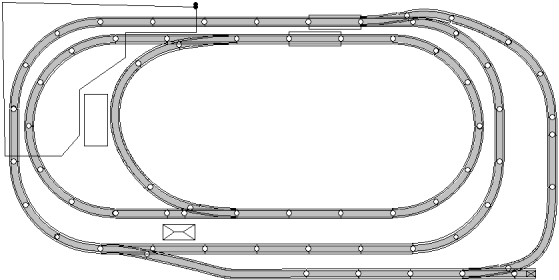
Brussels Northern
By Chuck Weber.
Extensively modified N scale version of "The Soo's Red Wing
Division", a 4x8 HO layout which appeared in December 1994 in Model
Railroader magazine. Our version uses Kato Unitrack and elevates the center
of the design.
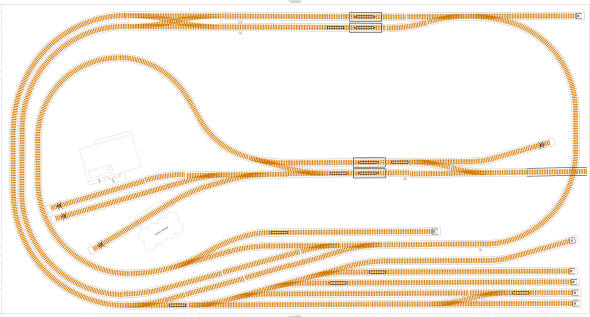
St. Paulton & Meriscove RR
By Bill Savage.
This is a passenger oriented layout, large stub terminal, coach and baggage
facilities, with a small engine terminal. Also, it is one-way (clockwise)
traffic flow. It is currently in the process of being constructed in N
scale.
Bill says "I have spent about a complete year in the design of this
passenger folly. Lots of fun. All done in autocad."
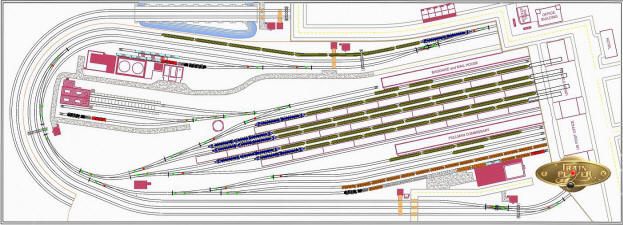
Miller Industries
By Jason Miller.
A basic yet very useful layout in a small area to utilize
businesses as drop off points. Two outer loops for continuous run but a fun
yet easy to use inner section of switching. In N scale.
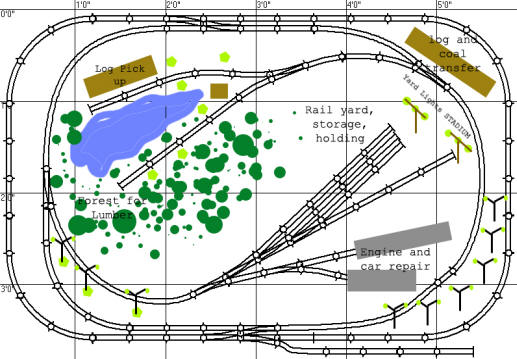
Axle Wrap RR
By Harry Vig.
Harry's first module, a scenic 2x8 switchback in
HO. Complete operating details enclosed. Plan by XTrkCad.

N-Scale Peanut
By Gary Jacobs.
Here is the whole layout of my first N Gauge (and model)
railroad. I call the design a double peanut. Both loops, high and low are
curved, something like a peanut. The time is circa 1900. No automobiles, but
covered wagons, oxen, horses, and bicycles. A trolley runs down both main
streets. Still trying to figure out catenary (wires) for them. Spur to the
top right, with caboose, will eventually join the second board that I am
working on.
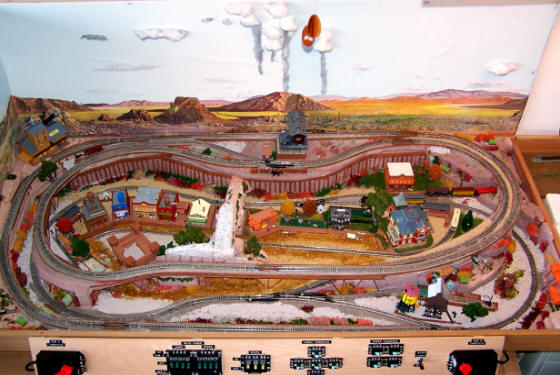
Sandric & Lake Superior RR
By Eric Lundberg.
The S&LS is in reality the Royal Gorge
Route of the Denver & Rio Grande Western RR. Allowing for the necessary
selective compression, I model the D&RGW in its entirety. This means the
mainline between Pueblo, Colo. and Salt Lake City, Utah. And it includes the
Moffat line to Denver. Denver, Pueblo, and Salt Lake are all represented by
staging yards.
It is HO. It is both narrow and standard gauge. There is approximately 2100
feet of track. On the plan the standard gauge is printed in black, narrow
gauge in green and dual gauge in red. The layout is in a basement measuring
43-feet 3-inches by 34-feet. Heights at various points are indicated in
inches inside a circle.
This layout demonstrates a
new feature of TrainPlayer version 2.14. The two levels are in
separate files, but the train can travel between them. If you have a big screen, you
can tile the two layouts and watch them both at once. TrackLayer users
should turn off track display for better appearance.
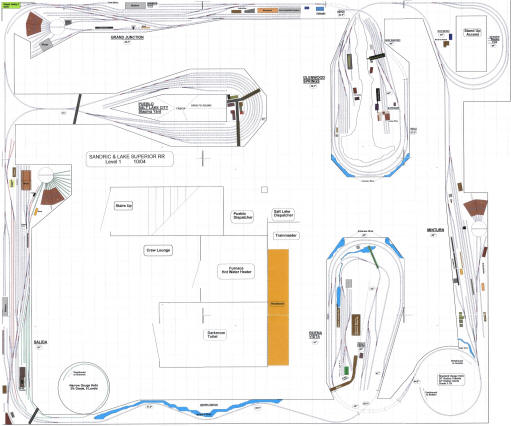
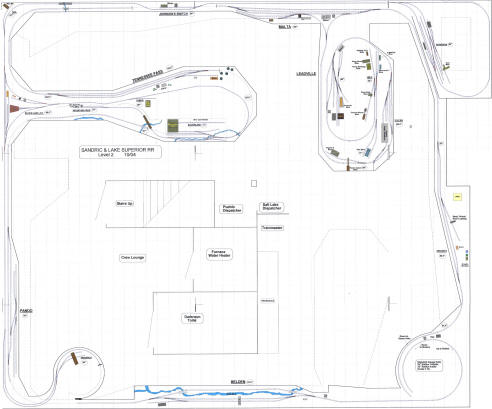
John
Hubbard's Next Layout
By John Tryon Hubbard.
I'm currently building a small layout that may be
interesting. As it stands right
now, I have most of the track laid and am pausing to do some scenery work
that must be done before I can proceed.
One thing that has been added to this layout concept is that between the
time I started thinking about it (3 years ago) and now, I built a HOn30
Class A Climax loco. So the layout will be its new home.
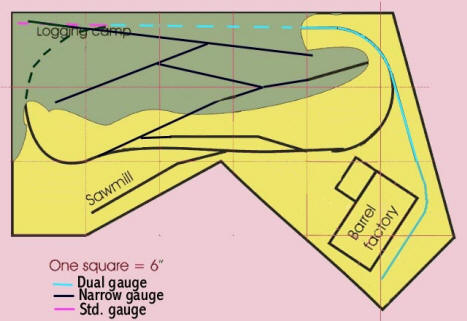
This HO-scale layout is less than three feet long! A
true micro layout.
Southern Pacific Tucson Division
By Phil Scandura.
Phil Scandura's N Scale layout, the
Southern Pacific Tucson Division "West Valley District," depicts a fictional
branch line connection between the Southern Pacific and the Santa Fe
railroads, just outside of Phoenix, Arizona. The branch starts in Glendale,
as an interchange with the Santa Fe mainline, and continues through Tolleson
and into Avondale where it joins the Southern Pacific mainline bound for
Yuma. Layout is controlled by Digitrax DCC and was originally designed using
CADRail layout design software.
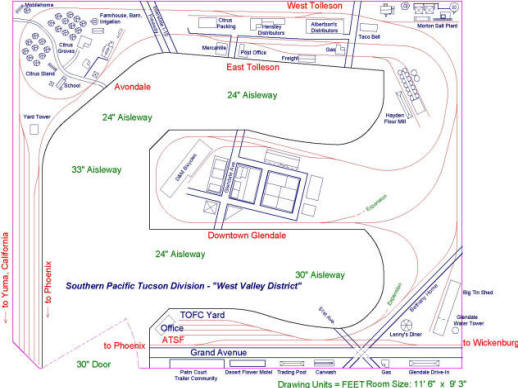
San Ramon
Valley Railroad
By Stephen Foster.
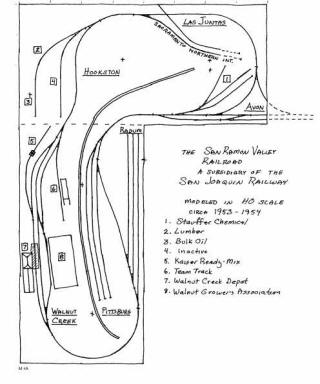
Industry & Yard
By Paul Omilian. Industry & yard with hidden staging under
the industry tracks.
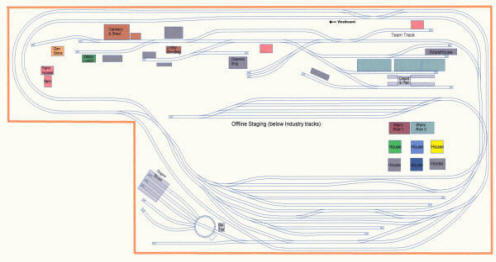
Kingfield & Kennebec RR
By Ed Kozlowsky.
On2 layout of a fictitious link between
the Franklin & Megantic at Kingfield, Maine, and the standard gauge Somerset
Railway in North Anson, Maine in the year 1895. Sidings pending on lower
portion. Benchwork is nearly complete, with some track layed.
Beautiful two-level railroad with
excellent rendering and a four-layer helix.
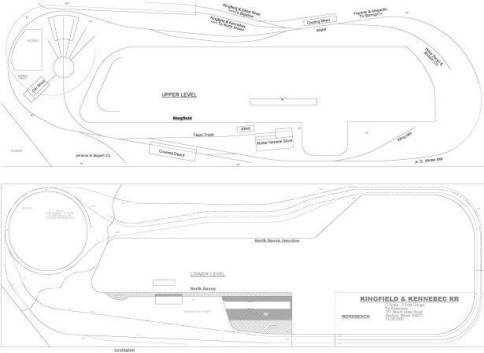
Westport Terminal RR
Wolfgang Dudler's HO-scale empire
in Germany -- the new revised version (the original is
below). For photos and lots of
details, see Wolfgang's site and the
Westport Terminal page.
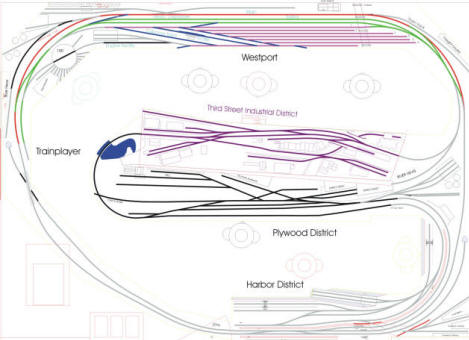
Walla Walla Valley Railway
By Blair Kooistra Artwork by Donovan Furin.
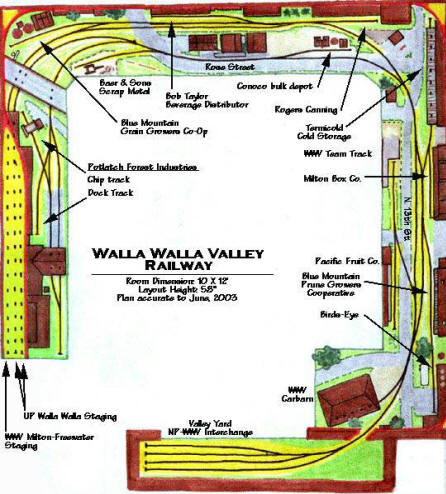
Georgetown Branch
By Kelly Regan. Top
plan is the latest; below is the now-gone past version.
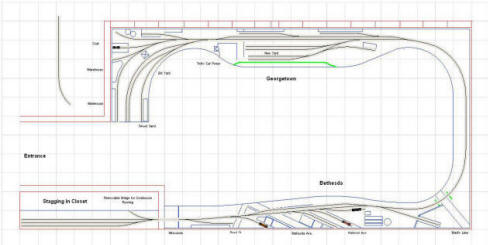
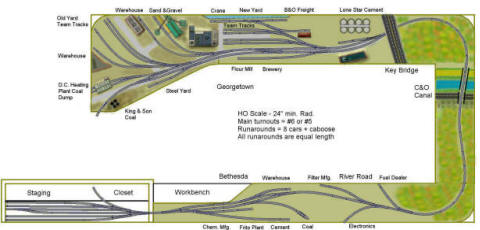
Michigan Eastern & Ohio Western
By George Baustert.
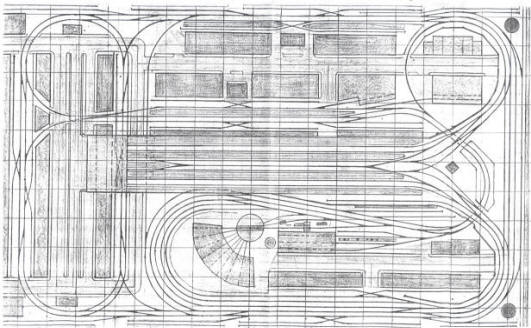
George says:
The Tennessee Eastern Ry, #93 in the 101
book, was the inspiration for the Michigan Eastern & Ohio Western, called
the "cat's meow" by those who appreciate great model railroading. It has a
major passenger station that features head in and back in from two
directions plus 2 suburban stations. It features steam and diesel locos and
the service tracks and engine houses for both. Traffic runs out and back, in
both directions, east and west with around the room running and several
return loop patterns. A double track interchange at the right end and
multiple industrial sidings along the right of way provide plenty of
switching beyond the main yard switching.
The main station and platforms are elevated above the rest of the layout,
which is flat and has multiple crossings. The main station is reached from
below via a long street ramp out in the front at the left end. Road and
buildings are located below the station and platform area.
The freight yard and especially the freight yard lead, both follow the grade
approach to the station on the front side of the layout. Likewise, the
industrial tracks along the rear of the layout follow the grade approach and
a connecting loop track provides quick access to the service area below.
Otherwise, engines have to run around the freight yard to get to the service
area. This is similar to the layout and is where I got the idea from. The
rest is all my own doing.
The layout is HO scale, 11'6" x 18'8", 3/4"= 1' grid. The frieight yard and
roundhouse are at the front of the layout.
The First George Baustert Collection
22 interesting and intricate layouts
designed and hand-drawn by George Baustert. Layout descriptions
include operation and historical commentary by George. Download all 22
together as a package.
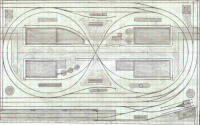
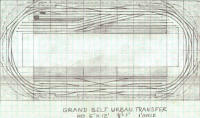
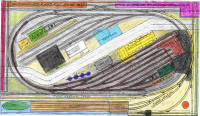
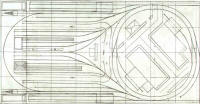
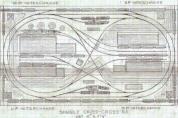
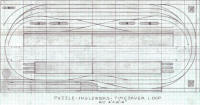
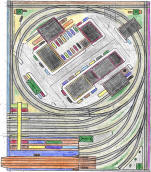

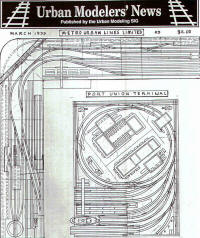
Napa Valley Northern
Giant club layout at the fairgrounds in
Napa, California. .
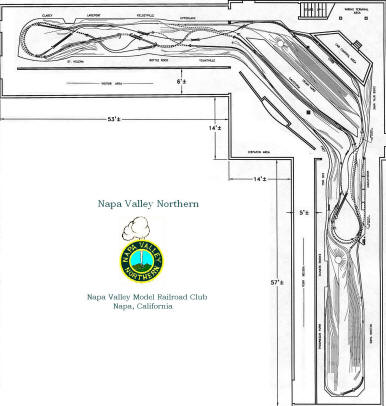
Southern Tier Connecting Railroad
By Al Olsen, Voorheesville, NY.
Plan by
Railplan, Baltimore. A short line between Binghamton and Elmira, NY.
Elegant plan.
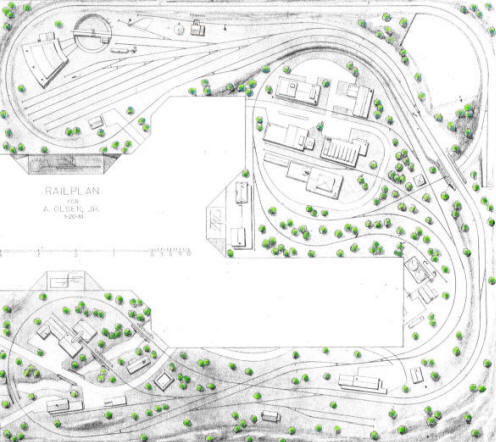
Rio Grande Southern
By Steven Haworth.
An
alternate-history version of the Rio Grande Southern, assumming it had been
standard gauged at some point and survived to at least 1958. Current details
on the RGS itself and this layout at
rgsrr.info.
Compare with the
Larry Nyce version from
Finescale Railroader Annual.
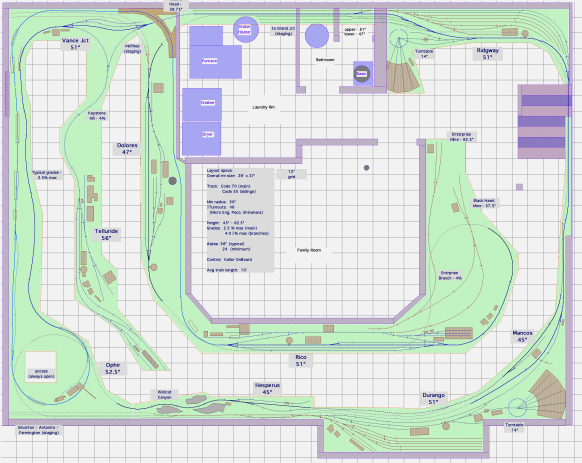
Angmar, Tharabad and Sarn Ford Rwy
Drawn and submitted by Peter Prunka.
According to Peter: The Angmar,
Tharabad and Sarn Ford Rwy. (AT&SF) was created as an homage to J.R.R.
Tolkien's Middle Earth. The railway represents Middle Earth at the dawn of
the Sixth Age, around 1945 in our terms. The railway was designed using
Tolkien's own topological maps of Middle Earth and represents the mainline
of the railway from the Iron Hills in the north through its connections with
the Gondor and Rohan in the south, along with a subsidiary line (the Bree,
Rivendell, Eregion and Eastern) through Elven territory at Rivendell and
hobbit country at Bree, terminating at Eregion.
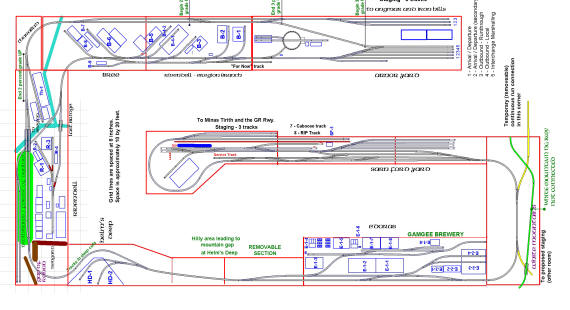
Santa Maria
Valley RR
By Byron Henderson.
Featured in Model Railroad Planning 2004. See
Byron Henderson's site.
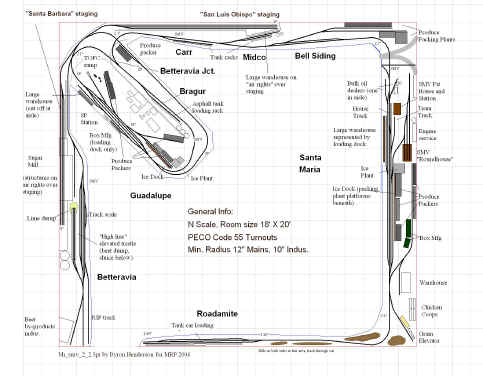
Westport Terminal RR
Wolfgang Dudler's HO-scale empire
in Germany. See
Wolfgang's site and the
Westport Terminal page.
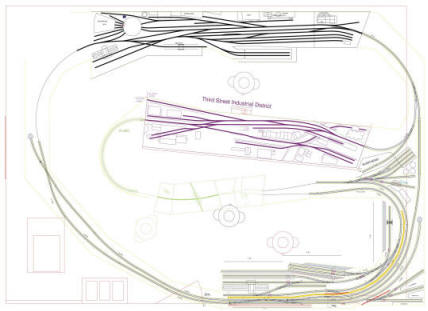
The Denver, South Park & Pacific
This layout was created by Andrew Dodge
and featured in the 2004 edition of Finescale Railroader Annual.
Submitted and tracked by Larry Kuretich.
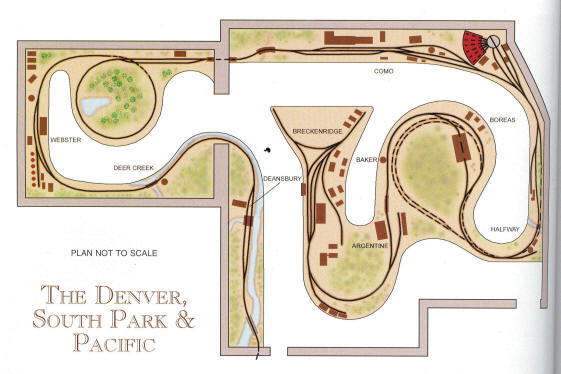
COPYRIGHT 2004
FINESCALE RAILROADER MAGAZINE / WESTLAKE PUBLISHING COMPANY. USED WITH
PERMISSION. ALL RIGHTS RESERVED
Rio Grande Southern
This layout was created by Larry Nyce and
featured in the 2004 edition of Finescale Railroader Annual. Submitted
and tracked by Larry Kuretich.
Compare with the
RGS built by Steven Haworth
on the User Layouts page.
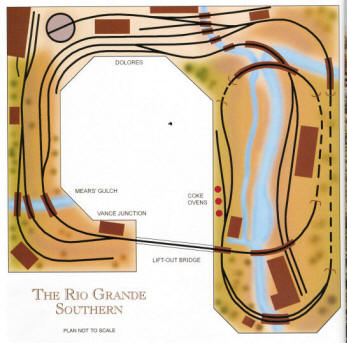
COPYRIGHT 2004
FINESCALE RAILROADER MAGAZINE / WESTLAKE PUBLISHING COMPANY. USED WITH
PERMISSION. ALL RIGHTS RESERVED
Possum Valley RR
Contributed and prepared by
Steve Ward.

Central Appalachian RR
Contributed and prepared by
Casey Sterbenz.
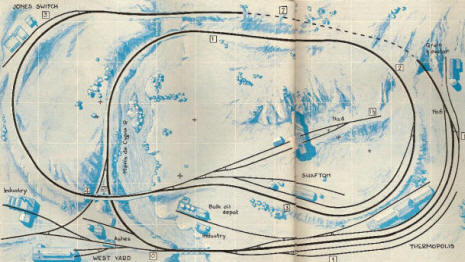
GM &
GP
By Paul
Omilian
The GrandMa & GrandPa RR! Our seven year old grandson is quite into
trains. I built a 4x8 Tyco layout for his Dad twenty five years ago and it was
up against the basement wall 'till the grandson came along. Needless to say it
has just snowballed since then. Still run some of the old Tyco stuff when he
wants to see "crashes" at the cross-overs, which is most of the time.
The layout is built on three 4x8 tables. Prodigy Advance DCC control. Completely
freelance, no time period, just fun! Laid out with Atlas Right Track
Software.
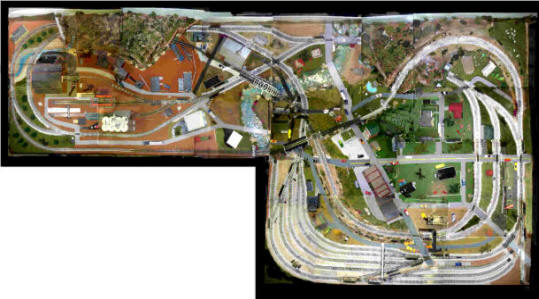
[Paul took the photo and applied the track using a beta version of TrackLayer.]
Atlas HO-28 Granite Gorge and Northern
Contributed and prepared by
Richard Kuroski
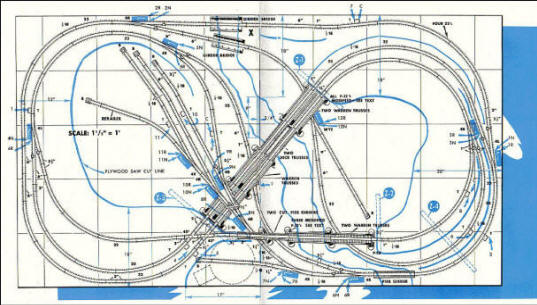
Farquhar Branch
Contributed and prepared by
Steve Ward
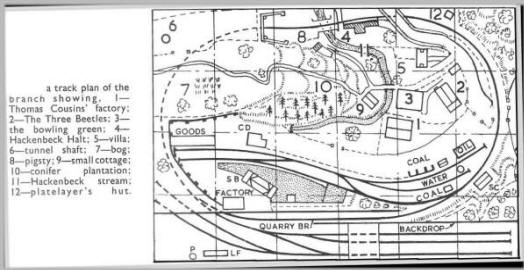
Midland Short Line
By Eric
Skinner
The Midland Short Line (MSL) is a freelance On30 line. Two versions were
submitted: the first is built and operating, the second is a plan for a possible
rebuild.
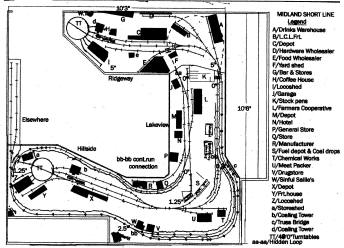
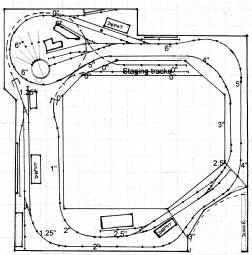
Callahan Central
By Steve
Ward
This layout is a combination of 3 layouts in one: the Callahan Central, the
Cripple Creek and a timesaver .
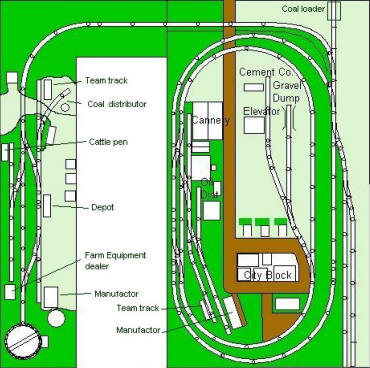
Boy's Life 4x8
Submitted by
Glenn Barton
This layout is from an old issue of Boy's Life, a favorite of Glenn Barton's
since youth.
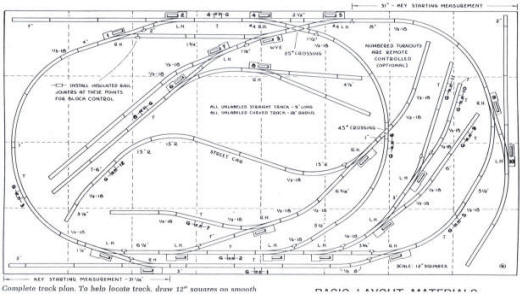
Bill Koehn's 6'x15'
N-Gauge Union Pacific Empire
Adapted and expanded from an S-gauge
layout in COMPLETE LAYOUT PLANS, FIFTH ENLARGED EDITION by Carstens
Publications, and drawn with RRTrack. Plan features 4 independent but
interconnected loops: 2 inner and outer ovals, and 2 middle figure 8's which can
easily be connected to form a much larger folded dogbone. Trains travel
counter-clockwise in outer 2 loops and clockwise in inner 2 loops but with no
reversing loops anywhere in the layout. DCC operation throughout. All Kato
Unitrack except Tomix turntable.
[Bill prepared this layout himself,
using a beta version of TrackLayer.]
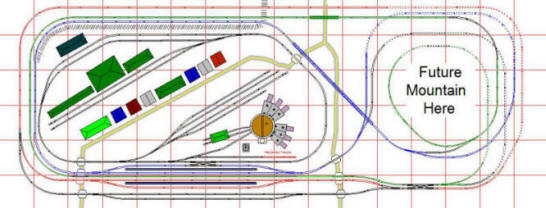
Bill Koehn's 3'x5' N-Gauge
Coffee Table Layout
Just a simple folded dogbone with
passing siding, water mill with stream & pond, and 3 industrial sidings.
Trackplan drawn by RRTrack. All Kato Unitrack. Layout is in wooden frame with
plexiglass cover and part of mountain lifts off in case of derailment in tunnel.
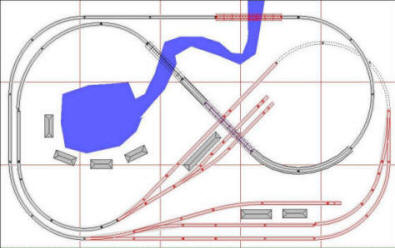
Blackjack Ridge
By Jim Kline
Blackjack Ridge is a small (3 x 8) N
scale layout that hides behind the couch in the family room. It represents a
sectional repair and servicing facility with a holding yard somewhere along the
CSX system. Additional industries, or maybe the time-saver switching puzzle,
will be added in the open area in the center.
The stations marked UNCPL are the locations of the MTL uncoupling magnets. Cars
must be uncoupled at these locations and the steam switcher can only push cars
to the spot location. (Micro-Trains Lines Magne-Matic coupler operation).
Build a train, pick-up the empties, spot the new cars and then classify the
empties back into the yard. Use the Clock tool to keep score.
Jim Kline drew this layout completely freehand using TrackLayer 1.26.
There is no background image.
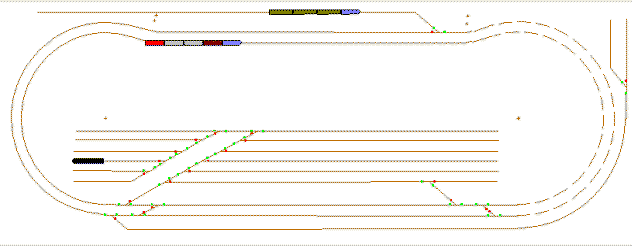
Michigan Central Division
By George Baustert
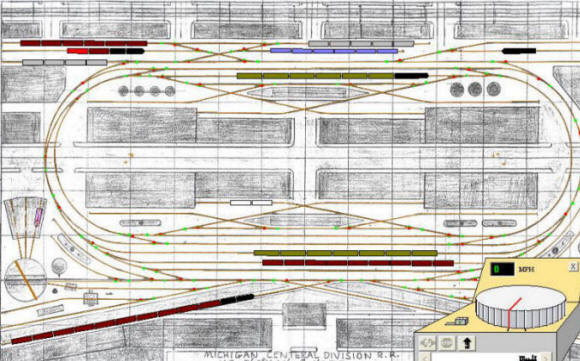
From George:
I noticed that locos and trains automatically backed up after running out of
track, especially at the edges of the layouts, so I figured we could use
this feature in an elevated line at the back of a layout and so this one was
born. However, it went through several stages, before it finally was
completed. (A single commuter unit would do.) It started out shorter
and narrower and I just kept adding to it. It is more of a game board
layout, what with a turntable at each end of a common yard, which started
out as visual staging and can still be used that way.
The idea is for the yard to be thought of as a division point where locos
arrive and are turned to go back over the same track that brought them.
Thus, when arriving from the west (left) they will pass the turntable there
and then after stopping and uncoupling from the train, they will go back to
that turntable, via the main line and get serviced and turned. Then, for the
return trip, they simply get onto their train at the end closest to their
terminal, the left one.
When they arrive coming from the east (right), they run past that turntable
and do the same as before, but in the reverse directions. After being
serviced and turned, the loco will take a new train back over the line and
arrive as it did the first time. Etc. etc. etc. Passenger trains do
the same thing, except that they back into the station platforms, upon
arrival and then leave with the other train, going back over the line.
The curved crossover just past the center to the rear is used by the yard
switcher to get to arriving and departing trains, which are then switched
onto one of the 3 tracks, used as the yard. These are also used when
switching the industries next to them. The rear side of the layout has
industries on both sides of the mainlines and is switched by the way freight
trains. Likewise, the industries on the right end. A passenger train
can be parked on one of the through tracks so that freight cars can be
spotted at the front of layout industries, as a diversion of operation.
Passenger trains can also make "whistle stops" at the platform on the rear
side of the layout, while the operator does other moves with other trains.
Likewise, it can do a "whistle stop" at the front. The second sidings at the
rear industries can be used as interchange tracks. Multiple use of tracks is
the key to diversified operation.
Timesaver
John Allen's classic switching puzzle,
drawn and built by Charlie Comstock.
The TrainPlayer version comes with a
pre-recorded solution. See Layout Properties for instructions.

Farmersville Jct
Classic switching puzzle by Robert
Hargrave.

Double Crossing Belt
by George Baustert
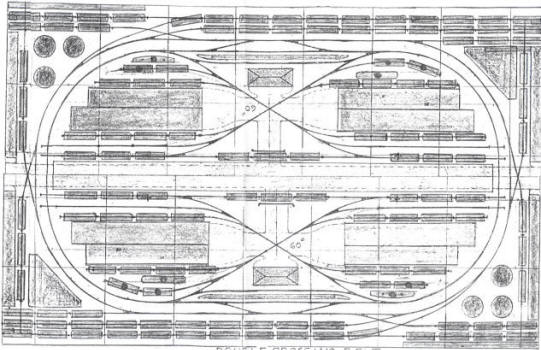
George says:
The DCB started out as a study layout and thus
has a number of innovations. It resembles a figure 8, but is not. It has 4
switchbacks in the center area, only 2 at the interchange tracks, like the
Grand Banks has. The end sidings are longer, thanks to the 30-degree
crossings. The mainline crossovers are located in the center, rather than
towards the ends and the service areaas are also moved.
Two passenger stations are provided. The train is to be created and deleted,
upon demand. Likewise, locos. The rear triangle area on the right is a cattle pen with ramp into the
building, which is a meat-packing house. The rest is up to you to decide.
With no staging tracks or carfloat, the outer interchange tracks become the
prime source of traffic, except for the passenger trains, which can be made
up on the end area of the outer loop or even on one of the end sidngs and
then run around the outer loop and crossed over to the inner loop to make
station stops and then exited (deleted) out of any available siding at the
outer edges, that run off of the layout and thus connect with the world,
beyond the layout.
The main street runs beneath the building and under the track at both ends,
steep ramps up to the stations. There are 62 40' cars on the interchange
track and an equal number at the industrial sidings, so the system is
balanced and no cars will need to be added or deleted, once the system is
filled. Of course, cars and locos can be changed at any time, on
TrainPlayer.
Wisconsin Central
Submitted by Chris Gilbert in
England. Based on industry around Menasha, Wisconsin.
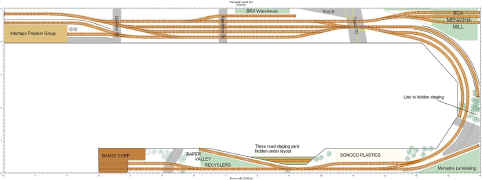
Two Layouts
From the design collection of Robert
Daniels. Prepared with Microstation.
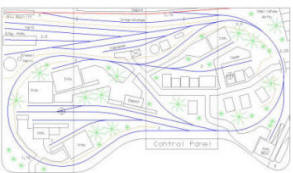
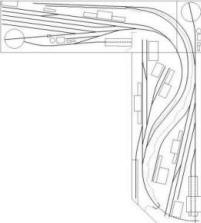
|